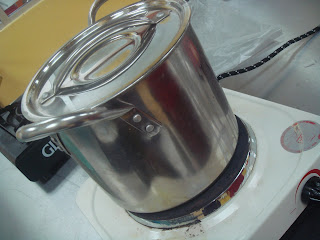Mysterious Behind It
Friday, October 30, 2009

·Rice is rich in carbohydrate which consists of starch and fiber as well as small quantities of potassium, the B vitamins, thiamin and niacin (Pechsiam, 2003).
·As rice composed of about 90% starch, rice-cooking involves reaction of starch in water at elevated temperatures. Absorption of water by starch granules as well as the swelling of the granules occurs as the heating treatment continues.
·At a certain temperature which is known as gelatinization temperature, the cell wall of the granule breaks and the starch turns viscous and hence, gelatinization happens during cooking of rice (Dr. Fred Shih, 2007).
·During cooking of rice, the heat and liquid start permeating the surface of the rice. The rice absorbs water slowly until all the water is used up. If the amount of water present is not sufficient, the rice will eventually absorb all the water until it has been all used up.
·The heat from the pot slowly roasts the rice grains as cooking continue. As a result, the rice will be undercooked and firm in texture with a bottom layer which has be burned forming a layer of brown crust (Admin, 2008).
·To get rid of this problem, onions are proven to be the most effective way to remove the smoky smell of the burned rice.
·Onions contain 89% water, 1.5% protein, and vitamins, including B 1, B 2, and C, along with potassium as well as alliin and similar sulfur compounds, including allylalliin and methyl and propyl compounds of cysteine sulfoxide (Bandyopadhyav et al., 1970).
·The flavor of freshly-cut onions is to a large extent based on a great variety of sulphur compounds which are propanthial-S-oxide and thiosulfinates. 3-Mercapto-2-methylpentan-1-ol is another intense flavor which is isolated from raw onions (Widder et a.l, 2000).
·When a knife cuts through the cells of an onion, its enzymes release a strong odor. Its ruptured cells release different components, like allinase enzymes and amino acid sulfoxides. The allinase enzymes break the amino acid sulfoxides down into sulfenic acids. The unstable sulfenic acids spontaneously rearrange into thiosulfinates, resulting a pungent odor. The acids are also converted by the LF-synthase enzyme into a gas called propanthial-S-oxide (Matt Soniak, 2009).
·3-Mercapto-2-methylpentan-1-ol is identified as another powerful onion aroma which produce more pungent odor.
·As the onion pieces shrivel and dry out, they will absorb smoky smell from the burned rice (Reiner, 2007).
References
Dr. Fred Shih, 2007. What chemical reaction is going on when cooking rice? [Online] Available from:http://www.chemistryquestion.com/English/Questions/ChemistryInDailyLife/35c_cooking_rice.html
Bandyopadhyav C, Srirangarajan AN, Sreenivasan A, 1970. Studies of flavour components of onion ( Allium cepa ) I. thin-layer chromatographic investigation of onion. J Chromatogr, 47, 400-407.
Widder et al., 2000. Enantioselective Syntheses and Sensory Properties of the 3-Mercapto-2-methylpentanols. J. Agric. Food Chemistry, 48, 413-423.
Reiner, A.R., 2007. Onions Remove Odors Naturally [Online]. Available from:http://www.suite101.com/blog/oilsdragon/onions_remove_odors_naturally [Accessed on 28th October 2009]
Admin, 2008. Rice Cooker Problems: Undercooked Rice [Online] Available from:
Matt Soniak, 2009. Why Do Onions Make You Cry? [Online]
Available from: < http://www.mentalfloss.com/blogs/archives/22202
[Accessed on 28th October 2009]
Pechsiam, 2003. Rice Nutrition Facts [Online]
Available from: < http://www.pechsiam.com/allabout_nutrition.htm >
[Accessed on 27th October 2009]


























